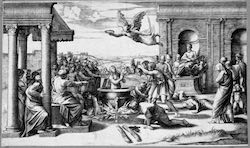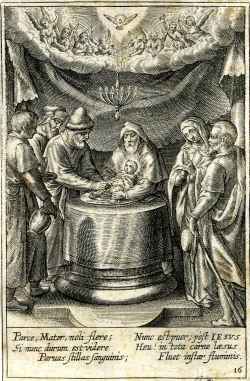Topic: 2. Sacrifice and religion: Comparisons, Antiquarians, Anthropology (16th-18th Century)
Religious sacrifices across various cultures and contexts sparked widespread interest in Early Modern Europe. As Christianity expanded into regions inhabited by "infidels" and "pagans", Europeans encountered a diverse array of sacrificial customs, ranging from the Sati rituals in India to the Aztec sacrifices in the Americas. This cross-cultural exposure captivated a wide audience, including theologians, philosophers, political thinkers, antiquarians, orientalists, missionaries, poets, artists, and even the general public. These encounters broadened the European understanding of sacrifice and led to a critical reassessment of classical and biblical sacrificial rites. This section includes:
- Sources: A selection of early modern printed materials, which include descriptions of the Americas, Asia, and Africa, alongside antiquarian and philological studies on religious sacrifice in classical antiquity and beyond. It also presents early modern works of ethnological observations and the first attempts to compare different sacrificial practices in various traditions and contexts, laying the groundwork for disciplines like the history of religions and anthropology.
- Iconographic Representations: A rich collection of images from the 16th to 18th centuries, illustrating a range of sacrificial rituals and practices as seen in different cultural and geographical contexts.
- Related Bibliography: An extensive bibliography spanning scholarly works from the 19th to 21st centuries, providing contemporary analyses and interpretations of these early studies and observations.
Sacré et sacrifice dans le Haut Atlas marocain
Casablanca: Afrique Orient, 1990.
The Rebound Theater State: The Politics of the Safavid Camel Sacrifice Rituals, 1598-1695 C.E
in: Iranian Studies, v. 37 (2004), issue 3: pp.451-478.
The rebound theater state: the politics of the Safavid camel sacrifice rituals, 1598-1695 C.E.
in: Iranian Studies, v. 37 (2004), issue 3: pp.451-478.
Saint Cecilia Martyrdom [1520 - 1525]
Warburg Institute, London, Bartsch Collection (XIV.114.107)
The Fragmentation of Sati: Constructing Hindu identity through nationalistic pilgrimage souvenirs
in: Journal of Decorative and Propaganda Arts, v. 27 (2015), issue --: pp.12-35.
Delle navigationi et viaggi, 3 vols.
Venice: Lucantonio Giunti, 1550.
Navigazioni e viaggi
Torino: Einaudi, 1980.
Hjotspring: Warfare and Sacrifice in early Europe
Aarhus - Oakville: Aarhus University Press, 1995.
Animal sacrifice and the problem of translation: the construction of meaning in Tuareg sacrifice
in: Journal of Ritual Studies, v. 16 (2002), issue 2: pp.141-164.
Time and Sacrifice in the Aztec Cosmos
Bloomington: Indiana University Press, 1998.
Human Sacrifice : Archaeological Perspectives from around the World
Cambridge: Cambridge University Press, 2019.
Angelic Death and Sacrifice in Early Modern Hispanic America
in: Death and Dying in Colonial Spanish America, pp. 142-69
Tucson: University of Arizona Press, 2011.
The Circumcision of Christ (1620-1626)
from: France. Series: Vita Deiparae Virginis Mariae
1. Sacrifice and Bible (16th-18th Century) 2. Sacrifice and religion: Comparisons, Antiquarians, Anthropology (16th-18th Century)
The Triumph of Christ´s Sacrifice (1733 - 1735)
from: Rentz, H. Das christliche Jahr, oder, Die Episteln und Evangelien [...], Prag, Labaunischen Erben, 1733 - 1735
The Collection of Prints and Drawings, British Museum, London
Wonder, and Absence: Our Distorted View of Moctezuma’s Tenochtitlan
in: A Companion to Viceregal Mexico City, 1519–1821, pp. 29-50
Leiden: Brill, 2021.
The Jewish Pig Prohibition from Leviticus to the Maccabees
in: Journal of Biblical Literature, v. 141 (2023), issue 2: pp.221-241.
The Prohibition of Local Butchery in Leviticus 17:3–4: The Evidence from the Dead Sea Scrolls
in: Semitica, v. 62 (2020), issue : pp.307-327.



